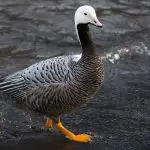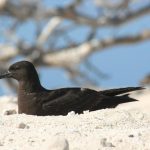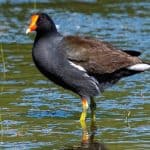Common Name: Eurasian Dotterel
Scientific Name: Charadrius morinellus| Size | Diet | Range in Hawaii | Status in Hawaii |
|---|---|---|---|
| 8 in. - 9 in. | beetles, grasshoppers, and ants | Unknown | Least Concern |
The Eurasian Dotterel (Charadrius morinellus) is a captivating bird species known for its striking plumage and unique behavior. With its warm brown back, chestnut breast, and striking white supercilium, this bird is a true marvel of nature.
While it is typically found in the high-altitude regions of Eurasia, it has also been known to make appearances in other parts of the world, including Hawaii. In fact, the Eurasian Dotterel is a non-breeding visitor and vagrant to the Northwestern Hawaiian Islands, where it can be spotted during the winter months.
In this article, we’ll take a closer look at this fascinating bird species, including its physical characteristics, behavior, and habitat preferences, as well as its presence in Hawaii.
Eurasian Dotterel
Appearance
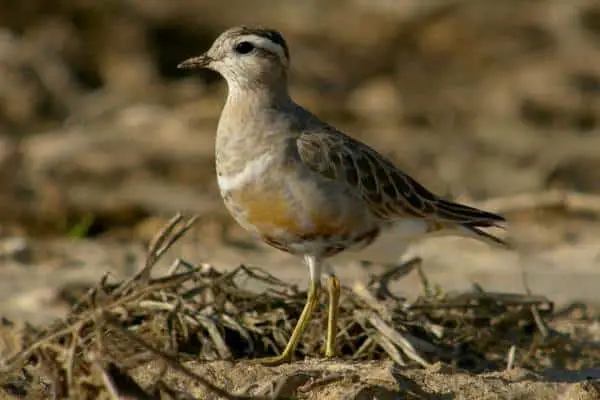
The Eurasian Dotterel is a striking and elegant bird with a captivating appearance. Standing at approximately 8-9 inches tall, this medium-sized shorebird showcases a delightful combination of colors. Its plumage features a rich blend of earthy tones, including chestnut brown, gray, and white.
The bird’s chestnut crown beautifully contrasts with its pale supercilium, forming a distinct and eye-catching facial pattern. Its breast and belly are pale, while its back and wings exhibit a mottled pattern, providing excellent camouflage in its natural habitat. The Eurasian Dotterel’s slender black bill and dark eyes add a touch of sophistication to its overall appearance.
Diet
As a shorebird, the Eurasian Dotterel primarily feeds on insects, particularly beetles, grasshoppers, and ants, which it skillfully hunts down using its sharp eyes and agile movements. During breeding season, when the birds nest in upland areas, their diet expands to include a wider range of invertebrates such as spiders, worms, and caterpillars. Additionally, the Eurasian Dotterel also relishes the occasional treat of seeds and berries when available.
Nesting
These birds are known for their unique breeding habits and their choice of nesting locations. Unlike many other bird species, the Eurasian Dotterel does not build traditional nests. Instead, it selects a simple scrape on the ground, typically on a patch of gravel or bare soil, blending seamlessly with its surroundings. This minimalistic approach to nesting allows the bird to camouflage its precious eggs from potential predators.
During the breeding season, which usually occurs in upland areas, the female Eurasian Dotterel lays a clutch of typically four eggs. The eggs themselves are beautifully designed, displaying an intricate pattern of mottled colors, perfectly matching the surrounding environment. This clever adaptation provides an extra layer of protection for the eggs, making them difficult to detect.
Once the eggs are laid, the responsibility of incubation is shared between both the male and female Dotterel. This cooperative effort showcases the bond and dedication of the breeding pair. The birds take turns incubating the eggs, ensuring their warmth and safety until they hatch.
The nesting period is a critical time for the Eurasian Dotterel, as it must guard its vulnerable offspring from potential threats. The parents employ a variety of distraction displays and alarm calls to divert attention away from the nest, ensuring the safety of their precious chicks.
Behavior
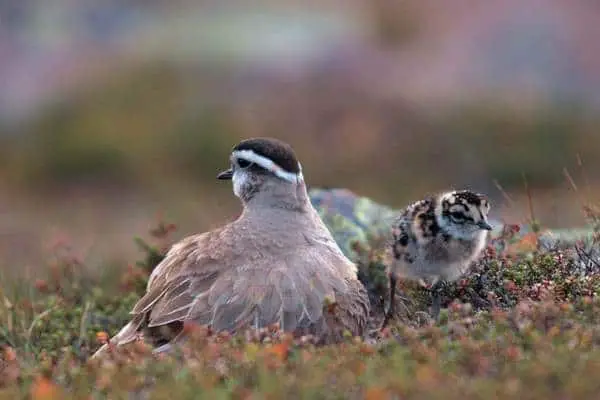
One remarkable aspect of the Eurasian Dotterel’s behavior is its highly synchronized migration. Each year, these birds embark on long journeys, traveling thousands of miles from their breeding grounds in the uplands to their wintering areas. What makes their migration even more astonishing is their ability to form cohesive flocks and navigate together, relying on their exceptional sense of direction and celestial cues.
During the breeding season, the Eurasian Dotterel engages in captivating courtship rituals. Males showcase their plumage and perform elaborate displays to attract females. These displays often involve wing waving, head bobbing, and aerial acrobatics, creating a spectacle of grace and beauty.
Another intriguing behavior of the Eurasian Dotterel is its reliance on camouflage. When threatened, these birds employ a remarkable defense mechanism by freezing and blending seamlessly into their surroundings. Their cryptic plumage and ability to remain motionless make them incredibly difficult to detect, allowing them to evade potential predators successfully.
Socially, the Eurasian Dotterel demonstrates a hierarchical structure within flocks. Dominant individuals assert their authority through displays and vocalizations, while subordinate birds follow their lead. This social order plays a crucial role in group cohesion and ensures efficient foraging and predator detection.
In terms of foraging behavior, the Eurasian Dotterel employs a combination of visual and tactile strategies. They use their keen eyesight to locate potential prey, and their bills, equipped with specialized receptors, help them detect and capture hidden insects and invertebrates in the ground.
Habitat
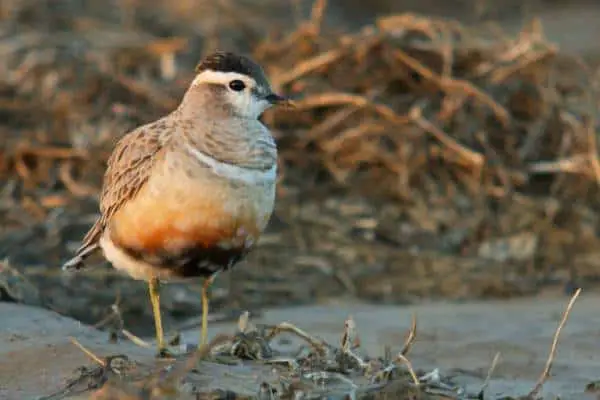
These charismatic birds can be found in various habitats across their range, including Arctic tundra, alpine meadows, moorlands, and barren rocky plateaus. During the breeding season, the Eurasian Dotterel prefers upland areas with open landscapes. They seek out habitats characterized by sparse vegetation, such as dry heathlands and gravelly plains, where they can easily blend into their surroundings.
In the winter months, the Eurasian Dotterel migrates to more lowland habitats, including coastal areas, grasslands, and agricultural fields.
Range
The Eurasian Dotterel is a non-breeding visitor and vagrant to the Northwestern Hawaiian Islands, particularly during the winter months. While this bird species is typically found in the high-altitude regions of Eurasia, it has been known to make occasional appearances in Hawaii.
Conservation Status
The conservation status of the Eurasian Dotterel is a topic of concern due to various factors affecting its population. The International Union for Conservation of Nature (IUCN) currently classifies the Eurasian Dotterel as a species of “Least Concern.” However, this classification does not indicate that there are no conservation issues to address.
Interesting Facts
1. Migratory marvel
The Eurasian Dotterel holds an impressive migratory record. It undertakes one of the longest known migratory journeys among shorebirds, traveling from its breeding grounds in the Arctic and subarctic regions to its wintering grounds in North Africa, the Middle East, and South Asia. Some individuals even make a non-stop flight of over 3,000 kilometers (1,800 miles) during migration.
2. Reverse sexual dimorphism
Unlike many bird species where males are more colorful or larger than females, the Eurasian Dotterel exhibits reverse sexual dimorphism. Females are typically larger and more brightly colored than males, with a richer chestnut crown and a more distinct facial pattern.
3. Named afterdots
The species name “morinellus” is derived from the Latin word “morio,” meaning “dotted.” It refers to the bird’s distinctive plumage pattern, with small dots and speckles adorning its upperparts.
4. Silent males
During the breeding season, male Eurasian Dotterels are known for their relative silence. While females produce soft, melodious calls, males are generally silent or make very subtle vocalizations, which adds to the mystique of their courtship displays.
5. Inspiration for traditional names
The Eurasian Dotterel has inspired various local names in different languages. For instance, in Scotland, it is known as the “Whaup,” and in some Nordic countries, it is referred to as the “Mountain Lark.”
Frequently Asked Questions
1. How do Eurasian Dotterels navigate during migration?
Eurasian Dotterels rely on celestial cues, particularly the stars, for navigation during migration. They have an exceptional sense of direction and can undertake long-distance journeys with remarkable accuracy.
2. Can Eurasian Dotterels swim?
While Eurasian Dotterels are not adapted for swimming like waterfowl, they are capable of crossing small bodies of water by wading or taking short flights. They are primarily terrestrial birds but can navigate water if necessary.
3. How can I spot a Eurasian Dotterel in the wild?
Spotting a Eurasian Dotterel can be challenging due to their remote breeding grounds and their relatively short stopovers during migration. Look for open, barren habitats with sparse vegetation, such as high-altitude meadows or coastal areas, where they may be foraging or resting during migration.
4. Can Eurasian Dotterels change their breeding sites from year to year?
Eurasian Dotterels tend to exhibit strong site fidelity, meaning they return to the same breeding sites year after year. However, in certain situations, such as habitat disturbance or changing environmental conditions, they may seek new breeding sites.
5. How long do Eurasian Dotterels live?
The lifespan of Eurasian Dotterels in the wild is estimated to be around 8-10 years. However, some individuals have been known to live longer, with the maximum recorded age being approximately 15 years.

